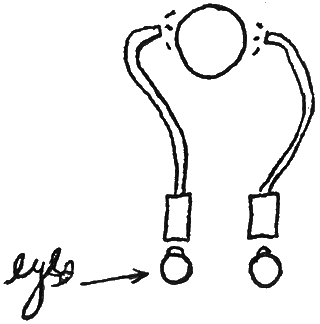Dear Professors,
I am only vaguely familiar with the concept of the fourth dimension, and your fascinating essay in the January Natural History will encourage me to investigate it. I believe that you are away of some points that I would like to make and ignored them for brevity’s sake, but let’s see.
One of the overriding proposals of the essay was that we cannot view both sides of an object at the same time. Actually there are several ways that this would be accomplished, the simplest, by the used of a septum and mirrors. A more easily-understood way would be to use two fiberoptic endoscopes, each focused on opposite sides of the object, and each viewed simultaneously by opposite eyes as follows (I’ll use a sphere since my drawings of cubes, viewed on opposite corners, appear confusing).

Note, however, that even though we have provided the brain with the simultaneous view of each side of the object, we have not enhanced the three-dimensional view into a fourth dimension. In fact, with no common detail visible to each eye, the percept is either diplopia if the two sides are too dissimilar, or fusion to a single, flat, two-dimensional disc.
The hand has many individual tactile sensors, which contribute to the 4-dimensional mental image of the penknife that the brain is programmed to interpret. If A-square were a Cyclops, he could not have appreciated the new stereoscopic view provided by the sphere; there are monocular clues to depth, but the 3-dimensional appreciation requires binocularity. Similarly, we are limited by the bilaterality of the visual system to a maximum view of three dimensions. By my calculation, four eyes, on flexible stalks, and the necessary brain functions to interpret the images would be the minimum requirement. (But you know, I really do not have any trouble visualizing this when I conceive of it this way, with four eyes and four endoscopes, perhaps because of my training. And I do recognize that we are minimizing the spatial elements in these examples).
There are two issues that I need to investigate regarding the 4th dimension. First, why is it necessary to understand it in visual terms, particularly human vision? Is this just a prejudice based on our human emphasis on vision? Why isn’t the hand/penknife example adequate, as it appears to be to me? Secondly, is this all very simplistic? Do we also have to incorporate a view from both insides as well as from the outside of an object to attain appreciation of the fourth dimension?
I better go dig out my old textbooks or hit the library.
Sincerely,
James L. Schmitt, O.D.
Muncy, Pennsylvania



